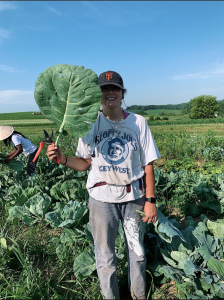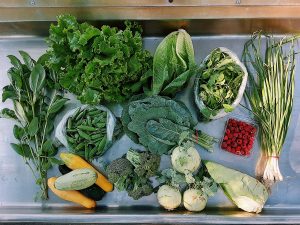
“The land knows you, even when you are lost.”
-Robin Wall Kimmerer
- Squash (All Shares)
- Kohlrabi (All Shares)
- Cone Cabbage (All Shares)
- Broccoli (All Shares)
- Basil (All Shares)
- Butter Crisp Lettuce (All Shares)
- Romaine (Full Shares)
- Collards (All Shares)
- Scallions (All Shares)
- Peas (Full Shares)
- Arugula (Full Shares)
- Raspberries (Single and Half Shares)
Farmer Notes
Crop of the Week: Collards!
A highly sought brassica, such as Cabbage and Broccoli, the crop of the week for Summer Share #4 are the strong and hardy Collard Greens. Feasted on by Humans, Flea Beetles and Cabbageworms alike (hence the holes that decorate some of our leaves), the collard green comes in shades of emerald and forest green, with a hint of magenta decorating the edge of some of these broad giants.

Collard Greens as a food dates back to the 1600s as one of the few crops enslaved families were allowed to grow and harvest for themselves, where many would stew them down into gravy formed from the leftover water and seasonings. Since then, it has become a staple in Southern cuisine; typically cooked to soak up the flavors of ham or other salted meats paired with it.
By themselves, Collard Greens are QUITE nutritious plants, which is easily reflected in their strong, broad stature, when compared to other plants leaves. They provide extreme vitamin and mineral nutrition and are capable of a multitude of benefits:
-Slowing the loss of mental functions.
-Promoting healthier lungs and cardiovascular protection.
-Helping to have a healthier transition through menopause.
-Providing Calcium and Phytonutrients and much more!
Beyond their many benefits and history, Collard Greens are extremely versatile when it comes to how you want to prepare them. Capable of handling the extreme environments of the cooking world, unlike most leafy greens, you can stew, braise, fry and saute them without worrying too much about them disintegrating into nothing, like most leafy greens do when added to heat. Some less known uses would be turning them into a salad or slaw, blending them into your daily smoothie, pureeing into a homemade pesto or even substituting a whole leaf for your favorite brand of tortilla for a much more nutrient rich and vegan friendly option.
Until you decide to use your greens, wrap them in a damp cloth and store them into a plastic bag to ensure freshness. Properly stored Collard Greens will last four to five days until you will want to dispose of them, unless you are savvy in the art of blanching your veggies to freeze for later use.
~ Farmer Jordan
Some recipes to try:
[ultimate-recipe id=”8164″ template=”default”] [ultimate-recipe id=”8172″ template=”default”] [ultimate-recipe id=”8153″ template=”default”]


